Reading Quotes
Learn more about reading quotes.
Futures prices are published for every trading session, and previous day prices are reported daily in major newspapers such as The Wall Street Journal (Section 2). You can also get prices for contracts traded at CME on the CME web site www.cmegroup.com and from a number of different quote vendors. Contracts are grouped into like commodities such as Food and Fiber, Metals and Petroleum, Financial, Livestock and Meat. The sample listing below for Index futures contains information from a Wall Street Journal listing.
Futures Stats
Over 395 million futures contracts were traded on U.S. futures exchanges in 1995.
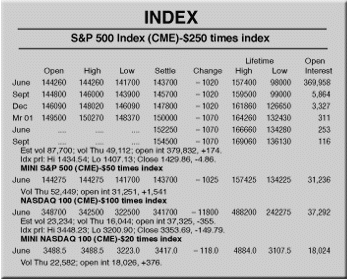
Let’s work through some excerpts from the sample listing on the previous page. In the section below, you see the name of the contract and next to it, in parentheses, the abbreviation of the exchange on which the contract is traded. In this case, the S&P 500 Stock Index contract is traded at CME. Just to the right of the exchange abbreviation (CME) is the multiplier – $250. That means that the value of the futures contract is determined by multiplying the index number times $250.
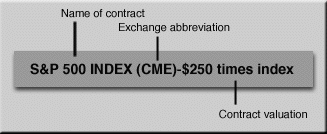
(Note: Prices on index futures are presented somewhat differently from prices on other kinds of futures contracts. If you were looking at prices for a Live Cattle contract, for example, you would see the size of the contract and the cost per unit instead of the index multiplier. With Live Cattle, a contract represents 40,000 pounds of cattle. The prices quoted are listed as cents per pound, so 67.85 would mean 67.85 cents per pound).
Each contract maturity or delivery month is listed downward along the left margin. In the sample S&P 500 chart below, the June contract appears first because it is the most nearby contract traded. As you go down the margin, you see future delivery months in the calendar year for 2000 and beyond, eventually ending in September 2001.
Months Traded
- June
- Sept
- Dec
- March
Interpreting these Numbers
Now let’s look at the price listings on the sample selected below – the June 2000 S&P 500 contract.
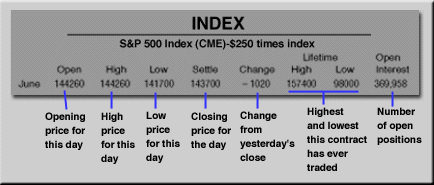
As you read across, you see a number of prices that provide a kind of “mini” price history for that contract. For the June contract, the first price – “Open” (144260) – is the opening price for this day’s trading. If you’re confused because you didn’t think the S&P 500 Index was that large, it’s understandable. Quote vendors present Index prices differently – some include decimal points, and others don’t. This sample is shown in Wall Street Journal style, with the decimal “understood” but not shown. (If it were shown, the price would read “1442.60.”)
Moving to the right, the next quote for the June contract is the High price of the day (144260), followed by the day’s Low (141700). Next you see Settle (143700), the closing price for this day’s trading session. After that is Change (-1020), the net change in the closing price from the prior day’s trading session. That means the June contract dropped by 10.20 points from the previous dayrsquo;s close.
The next two columns indicate the Lifetime High and Lifetime Low of each contract. Since the June contract’s inception the Lifetime high was 157400, and the Lifetime Low was 98000. The last item is Open Interest, which indicates the number of open positions in that contract. Open interest for the June contract reads 369,958, meaning there are that many June contracts still long and short in the market. Remember, one open interest refers to one complete trade (one trader buying from one trader selling).
Our next sample displays the final lines that appear after all the price quotes for each product.
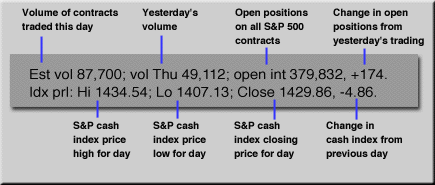
Options
Like futures prices, information on options prices can also be found easily in various newspapers and other venues. From the following table, based on a sample from The Wall Street Journal, you can find out the previous day’s closing prices for all available options, as well as strike prices and expiration months.
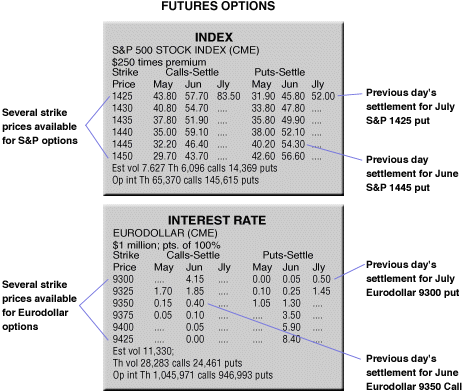
Here, we’ve highlighted the S&P 500 June 1440 call option. This call option settled (closed) at 59.10 index points. The right to go long or buy a June S&P 500 futures contract at a price of 1440 between now and June would cost the option buyer a premium of 59.10 index points. That would be $14,775.00 total for the premium (59.10 x $250 per index point).
Options Stats
Over 115 million options contracts were traded on U.S. Futures exchanges in 1999.
The buyer of the option pays the $14,775.00 premium to the seller of the option (and pays a commission to the brokerage firm). The seller of the option receives the $14,775.00 premium (but must also pay a commission to the brokerage firm).
If the futures advanced to 1445, the option would increase in value because the holder of the option has the right to buy at a lower price (1440) than is currently trading. (Notice that a June 1445 call option is worth less than a June 1440 call option because the right to buy the 1445 call is worth less than the right to buy lower at 1440.)
Only if the June S&P 500 futures price rises above 1440 will the 1440 call options gather any value. If not, then by expiration, the 1440 call option will waste away and eventually expire worthless. However, the most you could lose would be the premium paid.
Additional Lessons
- Futures Exchange
- Contracts Traded
- Supply and Demand
- Fundamental Analysis
- Technical Analysis
- Orders in the Pit
- Trading Pit
- Risk Management
- Hedgers & Speculators
- Options on Futures
- Reading Quotes
- GLOBEX
- Hand Signals
- Expiration Months
- Futures Contract
Contents Courtesy of CME Group.